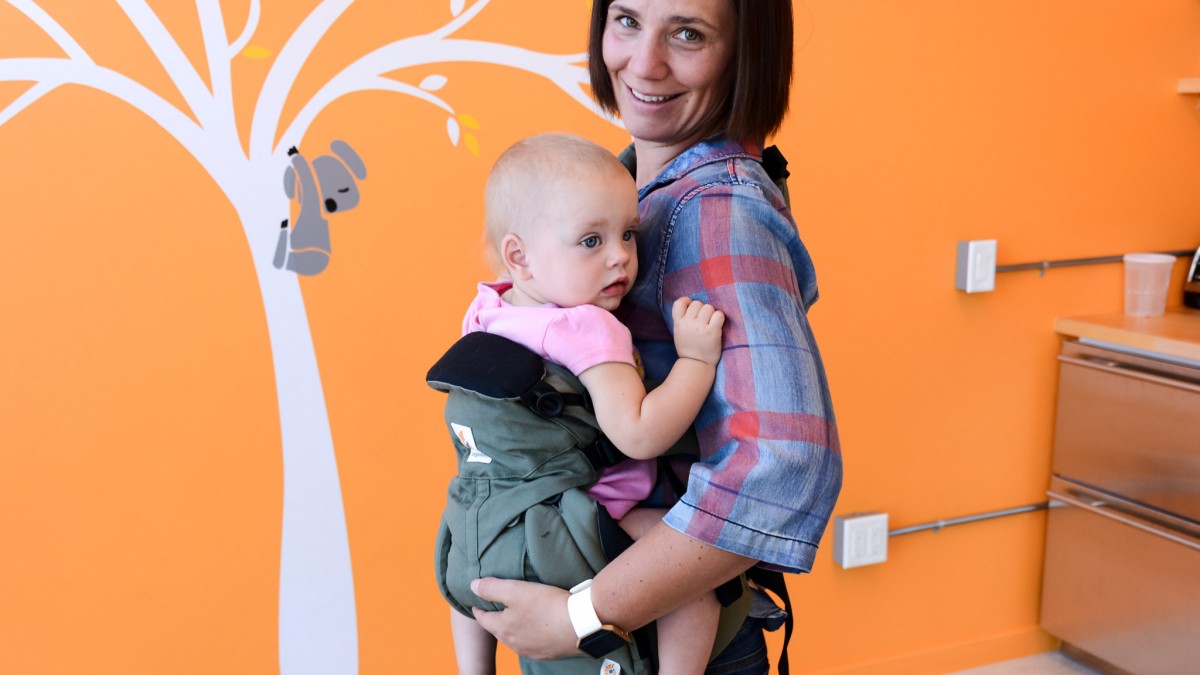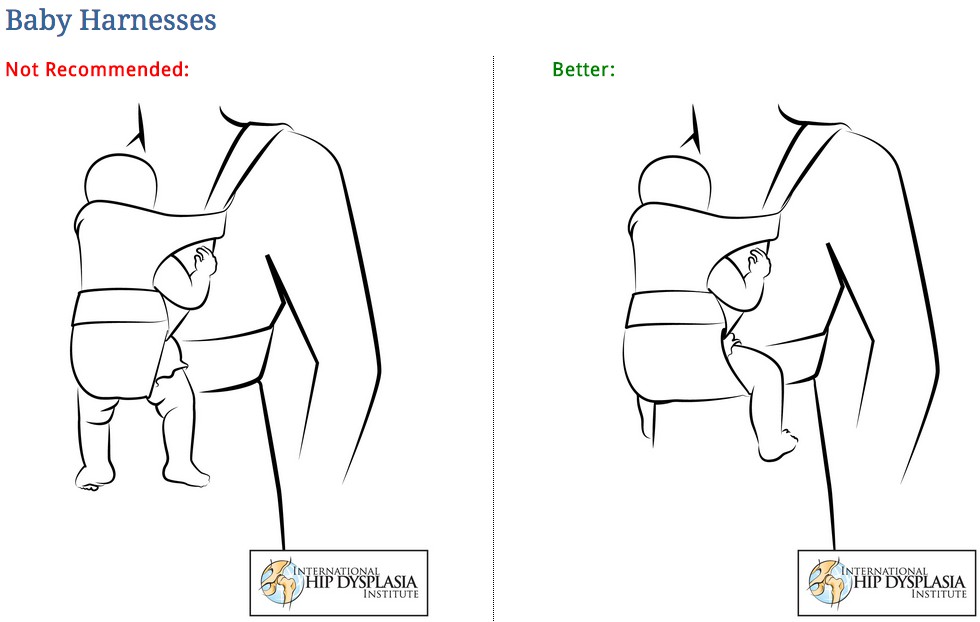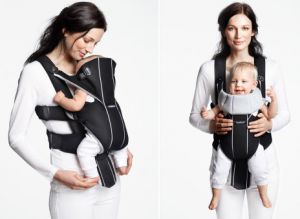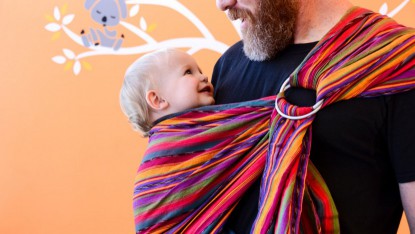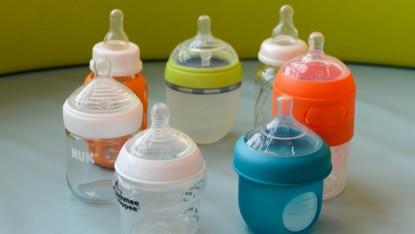This article was written as part of our Best Baby Carrier Review to provide guidelines for safe baby wearing practices.
General Safety Tips
Let's start off with some very basic and intuitive safety tips to keep in mind when using a baby carrier. The first is via a babywearing safety acronym titled T.I.C.K.S.
- With newborns, keep in mind that airway should be monitored closely as there is a very real risk of suffocation if baby were to assume a position where its chin is touching its chest. Read the section below titled, "Maintaining Baby's Airway."
- With infants in soft structured carriers, use only a forward carry with baby facing in position making sure that baby's head and neck are fully supported with two vertical finger widths between baby's chin and chest. Once baby's neck is strong enough to support their head themselves (typically about 4 months), you can use a face-out position.
- Always double-check that all buckles and knots are securely fastened
- Never drive a car or ride a bicycle while wearing baby
- Never drink hot liquids, such as coffee or tea, when wearing baby
Preventing Falls
One key safety consideration is how securely baby is carried. A fall from chest height is very dangerous for a baby. Baby should be closely held to the parent, and young babies should be provided a high back that fully supports baby's head and neck.
- If you need to pick something up, bend at the knee, not at the hip, so baby stays upright. Bending over at the torso while holding baby in a carrier brings risk of a backdive fall.
- Fabric should support baby's entire back to ensure they are securely seated and supported in the carrier. If a baby does not have control of head and neck yet, the fabric should also support the back of baby's head.
Start-off Keeping One or Two Hands on Baby
If you are new to baby wearing, or just started with a new type of carrier, take time to learn how to use it appropriately to ensure that baby is positioned both closely and securely inside. We recommend keeping one or two hands on baby at all times until you get used to a carrier, and are certain that all buckles and ties are secure. Over time, as you get comfortable with the carrier, you'll be able to have one or both hands free.
Supporting Head and Neck
Until baby's neck is strong enough to hold its head up on its own, baby's head and neck should be properly supported. This milestone typically occurs around four months of age. Do not attempt a front carry facing out position until baby has the strength to comfortably hold up their head on their own. Most babies younger than this are usually content being snuggled facing in right up against mom or dad's chest anyway.
A back carry position offers reduced support for baby, and the parent can't see what is going on with baby. As a result, back carry positions are not recommended until baby is a bit older, at least 6 months old, and many parents use front carry positions exclusively until baby is a toddler, which we feel is wise.
Maintaining Baby's Airway
Frequent care should always be taken with regard to maintaining an infant's airway in any baby carrier. Use extra care with infants under 4 months old and babies with colds or respiratory problems. Baby's face should be visible to you when baby wearing and head close enough to kiss. Be certain that their airway is never obstructed, either by your body or the carrier itself. Baby's nose and chin should be clear of fabrics and positioned comfortably keeping baby's chin away from touching its chest slightly extended, at least least two adult finger widths. Until baby has good head and neck control, positioning its head turned to one side or the other with cheek resting against the chest while in the front carry facing in position (that is, facing the parent) can help avoid this airway compromising chin to chest position. Several sling type carriers have been recalled in the last few years because when used incorrectly, they can pose a suffocation hazard to young infants.
Protecting Baby's Hips
One thing you'll notice when your pediatrician examines your newborn, is that they will perform a test of baby's hips. What they are looking for is symptoms of hip dysplasia, which is a fairly common development issue. The International Hip Dsyplasia Institute is a good source of information on how positional care in baby wearing can make a big difference in creating healthy hips. They also cover related topics such as proper swaddling, and guidelines for car seats.
Most hip development issues occur in the first 4 months of a newborn's life. Thus, special care should be taken with young babies. Baby wearers should allow for frequent breaks from the carrier so that baby can move its hips, knees, and the rest of the body around freely.
What is Hip Dysplasia?
The hip joint is commonly referred to in medical jargon as a "ball and socket joint," meaning the superior portion of the femur called the femoral head has a rounded shape like a ball which fits neatly into the rounded cup-shaped area of the pelvis called the acetabulum. At birth, a large portion of a newborn's partially developed hip joint is comprised of soft cartilage. The above illustration from The International Hip Dysplasia Institute highlights the key difference between the basic anatomy of an infant's hip compared to an adult's hip. Additionally, inside the womb and upon birth, newborn's joints are flexible and lax, the hips being especially prone to dislocating. Certain factors such as a family history of hip dysplasia or breech positioning, increase the risk of an infant having developmental hip dysplasia. However, chronic poor positioning in the first 4-6 months of life, can be a leading contributor as well. By 4-7 months of life, a large portion of this cartilage has turned to bone, increasing hip stability greatly.
Does the BabyBjorn Cause Hip Dysplasia?
If you google around and read blogs and comments on the BabyBjorn, it is not uncommon to find bloggers who who are convinced that the BabyBjorn causes hip dysplasia. We've attempted to research this in the medical community to determine if there is real data to support this assertion. Our conclusion is that this is a myth.
While we concluded that the manufacturer's claims that the BabyBjorn does not cause hip development issues are true, we have also concluded that the the best ergonomic positioning for hip development are not offered by the BabyBjorn Original but rather by competing carriers such as the Beco Baby Gemini. The Beco Gemini offer a wider seat, increased hip angles, and the ergonomic benefits of their design are particularly significant for the front-carry facing-out position with older babies (6-12+ months); which is the weakest ergonomic position for the BabyBjorn in our testing.
The 11 minute video below was put out by BabyBjorn, and features Dr. Amanda Weiss Kelly, a board certified pediatrician on staff at University Hospitals Rainbow Babies & Children's Hospital, and an expert in infant musculoskeletal health & wellness. While the fact that BabyBjorn sponsored this video had us skeptical, we find nothing in it that is misleading or appears to be medically inaccurate. Dr. Kelly does a good job of explaining infant hip development and hip dysplasia in the video. She also covers spinal issues. At 4 min 50 sec into the video, she addresses issue of whether the Bjorn is a cause of hip dysplasia. She notes there is "no evidence the front carriers [such as BabyBjorn] in any way contribute to developmental hip dysplasia." We concur. She goes further to note that the hip angles in the carrier are proper for hip development, and even match angles considered therapeutic. In the closing minutes, she addresses carrying postions, using facing-in for a newborn, and then switching to facing out once they can hold their head up (typically 4 months).Sling-type Carriers and Risks of Suffocation
The Consumer Products Safety Commission has issued several warning advisories about sling-type carriers in the last few years regarding the potential suffocation hazard they present young infants, especially in the first 4 months.
Inspired by 14 deaths since 1998, the CPSC also produced a helpful 3 minute video which urges parents to use extra caution with slings and cites key safety risks to be aware of:Sling-type Carriers and Risks of Hip Dsyplasia
In addition, sling-type carriers have been called out as potentially risky for hip development, if the baby's legs are in a straight position (see illustration below from the International Hip Dysplasia Institute).
We understand the perspective of many passionate sling fans, and it is certainly the case that by paying attention to the safety tips, many parents have safely used and enjoyed wearing their baby in a sling. However, given these two risks, we do not recommend sling-type carriers for babies in the newborn to 4 months age range.

